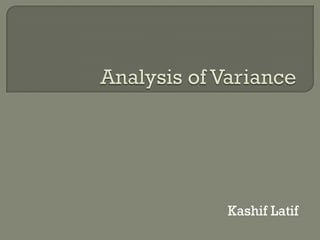
Analysis of Variance
- 1. Kashif Latif
- 2. A statistical method for making simultaneous comparisons between three or more means.
- 3. If we are only comparing two means, ANOVA will produce the same results as the t test for independent & dependent Samples.
- 4. The t-test can only be used to test differences between two means.When there are more than two means, it is possible to compare each mean with each other mean using many t-tests. But conducting such multiple t-tests can lead to severe complications and in such circumstances we use ANOVA.Thus, this technique is used whenever an alternative procedure is needed for testing hypotheses concerning means when there are several populations.
- 5. When you choose to analyses your data using a one-way ANOVA, part of the process involves checking to make sure that the data you want to analyses can actually be analyses using a one-way ANOVA. You need to do this because it is only appropriate to use a one-way ANOVA if your data "passes“ following assumptions that are required for a one way ANOVA to give you a valid result.
- 6. Dependent variable should be measured at the interval or ratio level. Independent variable should consist of two or more categorical, independent groups. Should have independence of observations. There should be no significant outliers. Dependent variable should be approximately normally distributed. There needs to be homogeneity of variances.
- 7. One of the principle advantages of this technique is that the number of observations need not be the same in each group. Additionally, layout of the design and statistical analysis is simple.
- 8. A manager wants to raise the productivity at his company by increasing the speed at which his employees can use a particular spreadsheet program. As he does not have the skills in-house, he employs an external agency which provides training in this spreadsheet program. They offer 3 courses: a beginner, intermediate and advanced course. He is unsure which course is needed for the type of work they do at his company, so he sends 10 employees on the beginner course, 10 on the intermediate and 10 on the advanced course. When they all return from the training, he gives them a problem to solve using the spreadsheet program, and times how long it takes them to complete the problem. He then compares the three courses (beginner,intermediate, advanced) to see if there are any differences in the average time it took to complete the problem.
- 15. SPSS generates following quite a few tables in its one-way ANOVA analysis. Descriptives Table ANOVA Table Multiple Comparisons Table
- 16. The descriptives table (see below) provides some very useful descriptive statistics, including the mean, standard deviation and 95% confidence intervals for the dependent variable (Time) for each separate group (Beginners, Intermediate and Advanced), as well as when all groups are combined (Total).These figures are useful when you need to describe your data.
- 17. This is the table that shows the output of the ANOVA analysis and whether we have a statistically significant difference between our group means.We can see that the significance level is 0.007 (p = .007), which is below 0.05. and, therefore, there is a statistically significant difference in the mean length of time to complete the spreadsheet problem between the different courses taken.This is great to know, but we do not know which of the specific groups differed. Luckily, we can find this out in the Multiple Comparisons Table which contains the results of post-hoc tests.
- 18. From the results so far, we know that there are significant differences between the groups as a whole.The table below, Multiple Comparisons, shows which groups differed from each other.The Tukey post-hoc test is generally the preferred test for conducting post- hoc tests on a one-way ANOVA, but there are many others.We can see from the table below that there is a significant difference in time to complete the problem between the group that took the beginner course and the intermediate course (p = 0.021), as well as between the beginner course and advanced course (p = 0.011). However, there were no differences between the groups that took the intermediate and advanced course (p = 0.960).
- 19. There was a statistically significant difference between groups as determined by one-way ANOVA (F(2,27) = 6.087, p = .007). A Tukey post hoc test revealed that the time to complete the problem was statistically significantly lower after taking the intermediate (23.0 ± 2.8 min, p = .021) and advanced (22.6 ± 3.8 min, p = .011) course compared to the beginners course (27.2 ± 3.0 min). There were no statistically significant differences between the intermediate and advanced groups (p = .960).
